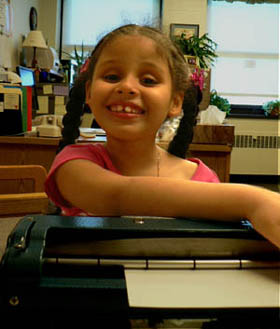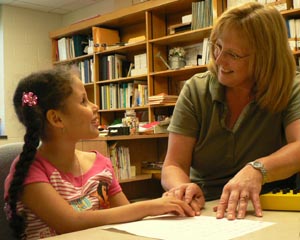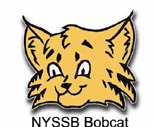 Braille
Braille
Braille Instructors:
Diane LaClair, Teacher of the Visually Impaired
Jamie Wallace, Teacher of the Visually Impaired
What is Braille? | Learning Braille | Free Braille Font | Braille Literacy Sources |
Braille Symbols
![]() | Legislation
| Legislation
![]()
What is Braille?
Braille is a tactile way to read, and used by children and adults who are unable to read print. It all begins with a simple structure of six dots arranged in two columns and three rows. Starting at the top of the left column, each dot is numbered 1 - 2 - 3 and on the right column 4 - 5 - 6. These six dots are the basis for all reading and writing code.
Those who read braille learn that different combinations of the six dot patterns can be used to create alphabet letters, numbers, punctuation, and other symbols to match those that are used in print text. Because braille characters can take up a great deal of space, certain characters can be used to represent parts of words and even whole words. This process uses less space on a paper, and is faster to read by a braille reader.
You can learn more about braille by visiting the
Braille Bug
![]() site.
site.
Learning Braille at NYSSB:
At the NYS School for the Blind, individual Braille instruction is an optional service for students who have developed an understanding of the Pre-Braille skills and the Braille alphabet. Pre-Braille skills consist of the basic concepts for texture, shape, and size. Also included are the locational skills for a page or book: finding the top, bottom, left and right, as well as tracking lines of Braille and moving quickly to the next.
Students benefit from individual assistance to learn the contracted Braille code and Nemeth Code (Math). Since there are only so many patterns that can be made with six little dots, one pattern may represent one thing when alone on a line, at the beginning, middle and end of a word. Students learn the rules that explain how they are used. It helps to think of contracted Braille, a Braille symbol or group of symbols represents words and punctuation, as a shorthand process to reading and writing. Literary Braille represents words and punctuation, while the Nemeth code is a system of Braille symbols that represent numbers, symbols, and processes used for mathematics.
Also important to teach, are the fundamental Braille reading techniques for finger and hand position, and how to use both hands together to track the lines, while the dominant hand concentrates on the reading. These skills have a great affect on how fast a person reads (reading rate), how fluent or smooth they read (fluency), and how well they remember what they read (comprehension).
Services for Braille instruction is determined through the IEP referral process for a student to have an assessment by a teacher of the visually impaired who is knowledgeable with Braille and Nemeth Code. A written evaluation is completed to determine whether the student is ready for individual instruction or whether pre-requisite skill training and objectives can be followed in the classroom through a consultation model.
Download Free Braille Font for your computer:
Would you like to add Braille font to your computers font choices? It is a downloadable file, that becomes part of your computers font choices. Once it is installed you will be able to use it in word documents, and you will be able to change the size, make it bold, and add to text files. Although it is not tactile for braille users to read it has proved to be very useful with to sighted and low vision users who are learning Braille as a way to compare text to the braille characters.
APH offers this braille font as a free download. Go to
APH.org
![]() .
Once on the webpage, choose Download APHont
.
Once on the webpage, choose Download APHont
![]() and
follow the instructions. Select 'submit', and a notification will be
sent with approval, and directions on how to proceed. It is relatively simple to do.
and
follow the instructions. Select 'submit', and a notification will be
sent with approval, and directions on how to proceed. It is relatively simple to do.
Other
Braille
font sources
![]() ,
including 6- or 8-cell braille font, sign language, and more can be found at
ClickInks.com
,
including 6- or 8-cell braille font, sign language, and more can be found at
ClickInks.com
![]() .
.


Students learn to read braille, and to write braille with a variety of
manual
and electronic braille embossing devices.

